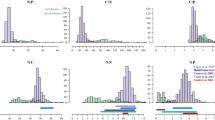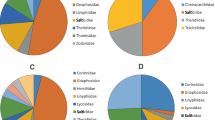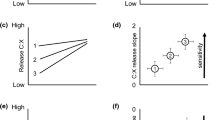Abstract
Previous syntheses have identified the key roles that phylogeny, body size, and trophic level play in determining arthropod stoichiometry. To date, however, detritivores have been largely omitted from such syntheses, despite their importance in nutrient cycling, biodiversity, and food web interactions. Here, we report on a compiled database of the allometry and nutritional stoichiometry (N and P) of detritivorous arthropods. Overall, both N and P content for detritivores varied among major phylogenetic lineages. Detritivore N content was similar to the N content of herbivores, but below that of predators. By contrast, detritivore P content was independent of trophic level. Contrary to previous reports, neither nutrient varied with body size. This analysis places detritivores in the context of related herbivores and predators, and as such, sets the stage for future investigations into the causes and consequences of elemental (mis)matches between detritivores and their detrital resources.


Similar content being viewed by others
References
Anderson TR, Hessen DO, Elser JJ, Urabe J (2005) Metabolic stoichiometry and the fate of excess carbon and nutrients in consumers. Am Nat 165:1–15
Boersma M, Kreutzer C (2002) Life at the edge: is food quality really of minor importance at low quantities? Ecology 83:2552–2561
Cárcamo HA, Abe TA, Prescott CE, Holl FB, Chanway CP (2000) Influence of millipedes on litter decomposition, N mineralization, and microbial communities in a coastal forest in British Columbia, Canada. Can J For Res 30:817–826
Caterino MS, Shull VS, Hammond PM, Vogler AP (2002) Basal relationships of Coleoptera inferred from 18S rDNA sequences. Zool Scr 31:41–49
Cebrian J (1999) Patterns in the fate of production in plant communities. Am Nat 154:449–468
Crawley MJ (1993) GLIM for ecologists. Blackwell Science, Oxford
Crawley MJ (2007) The R book. Wiley, London
Cross WF, Benstead JP, Rosemond AD, Wallace JB (2003) Consumer–resource stoichiometry in detritus-based streams. Ecol Lett 6:721–732
Davidson DW (2005) Ecological stoichiometry of ants in a New World rain forest. Oecologia 142:221–231
Denno RF, Fagan WF (2003) Might nitrogen limitation promote omnivory among carnivorous arthropods? Ecology 84:2522–2531
Elser JJ, Fagan WF, Denno RF, Dobberfuhl DR, Folarin A, Huberty A, Interlandi S, Kilham SS, McCauley E, Schulz KL, Siemann EH, Sterner RW (2000) Nutritional constraints in terrestrial and freshwater food webs. Nature 408:578–580
Elser JJ, Acharya K, Kyle M, Cotner J, Makino W, Markow T, Watts T, Hobbie S, Fagan W, Schade J, Hood J, Sterner RW (2003) Growth rate-stoichiometry couplings in diverse biota. Ecol Lett 6:936–943
Elser JJ, Bracken MES, Cleland EE, Gruner DS, Harpole WS, Hillebrand H, Ngai JT, Seabloom EW, Shurin JB, Smith JE (2007) Global analysis of nitrogen and phosphorus limitation of primary producers in freshwater, marine, and terrestrial ecosystems. Ecol Lett 10:1135–1142
Fagan WF, Denno RF (2004) Stoichiometry of actual vs. potential predator-prey interactions: insights into nitrogen limitation for arthropod predators. Ecol Lett 7:876–883
Fagan WF, Siemann E, Mitter C, Denno RF, Huberty AF, Woods HA, Elser JJ (2002) Nitrogen in insects: implications for trophic complexity and species diversification. Am Nat 160:784–802
Felsenstein J (1985) Phylogenies and the comparative method. Am Nat 125:1–15
Garland T Jr, Harvey PH, Ives AR (1992) Procedures for the analysis of comparative data using phylogenetically independent contrasts. Syst Biol 41:18–32
Grafen A (1989) The phylogenetic regression. Philos Trans R Soc Lond B Biol Sci 326:119–157
Hansen TF, Martins EP (1996) Translating between microevolutionary process and macroevolutionray patterns: a general model of the correlation structure of interspecific data. Evolution 50:1404–1417
Hunt T, Bergsten J, Levkanicova Z et al (2007). A comprehensive phylogeny of beetles reveals the evolutionary origins of a superradiation. Science 318:1913–1916
Killingbeck KT (1996) Nutrients in senesced leaves: keys to the search for potential resorption and resorption proficiency. Ecology 77:1716–1727
Klowden MJ (2002) Physiological systems in insects. Elsevier Academic Press, New York
Kristensen NP (1991) Phylogeny of extant Hexapods. In: CSIRO (ed) The insects of Australia. Melbourne University Press, Melbourne, pp 1137
Liermann M, Steel A, Rosing M, Guttorp P (2004) Random denominators and the analysis of ratio data. Environ Ecol Stat 11:55–71
Maddison DR, Schulz K-S (eds) (2007) The tree of life Web project. http://tolweb.org
Markow TA, Raphael B, Dobberfuhl D, Breitmeyer CM, Elser JJ, Pfeiler E (1999) Elemental stoichiometry of Drosophila and their hosts. Funct Ecol 13:78–84
Martins EP, Hansen TF (1997) Phylogenies and the comparative method: a general approach to incorporating phylogenetic information into the analysis of interspecific data. Am Nat 149:646–667
Mattson WJ (1980) Herbivory in relation to plant nitrogen-content. Annu Rev Ecol Syst 11:119–161
McNeill S, Southwood TRE (1978) The role of nitrogen in the development of insect/plant relationships. In: Halborne JS (ed) Aspects of plant and animal coevolution. Academic Press, London, pp 77–98
Moe SJ, Stelzer RS, Forman MR, Harpole WS, Daufresne T, Yoshida T (2005) Recent advances in ecological stoichiometry: insights for population and community ecology. Oikos 109:29–39
Moore JC, Berlow EL, Coleman DC, Ruiter PC, Dong Q, Hastings A, Johnson NC, McCann KS, Melville K, Morin PJ, Nadelhoffer K, Rosemond AD, Post DM, Sabo JL, Scow KM, Vanni MJ, Wall DH (2004) Detritus, trophic dynamics and biodiversity. Ecol Lett 7:584–600
Nooden LD, Guiamet JJ, John I (1997) Senescence mechanisms. Physiol Plant 101:746–753
Paradis E, Claude J, Strimmer K (2004) APE: analyses of phylogenetics and evolution in R language. Bioinformatics 20:289–290 (package available freely under the GNU General Public License at: http://cran.r-project.org/src/contrib/packages.html#ape)
Shull VL, Vogler AP, Baker MD, Maddison DR, Hammond P (2001) Sequence alignment of 18S ribosomal RNA and the basal relationships of Adephagan beetles: evidence for monophyly of aquatic families and the placement of Trachypachidae. Syst Biol 50:945–969
Shurin JB, Gruner DS, Hillebrand H (2006) All wet or dried up? Real differences between aquatic and terrestrial food webs. Proc R Soc B Biol Sci 273:1–9
Sterner RW, Elser JJ (2002) Ecological stoichiometry: the biology of elements from molecules to the biosphere. Princeton University Press, Princeton
Wardle DA (2002) Communities and ecosystems: linking the aboveground and belowground components. Princeton University Press, Princeton
Wheeler WC, Whiting M, Wheeler QD, Carpenter JM (2001) The phylogeny of the extant hexapod orders. Cladistics 17:113–169
White TCR (1993) The inadequate environment: nitrogen and the abundance of animals. Springer, New York
Woods HA, Fagan WF, Elser JJ, Harrison JF (2004) Allometric and phylogenetic variation in insect phosphorus content. Funct Ecol 18:103–109
Yeates D, Meier R, Wiegmann B (2006) FlyTree: phylogenetic supertree of Diptera. http://www.inhs.uiuc.edu/research/FLYTREE/supertree.html. Accessed 13 April 2006
Acknowledgments
WFF wishes to thank A. Satake and the other members of the Program Committee for inviting him to speak at the 2007 meeting of the Japanese Ecological Society where these results were first presented. This paper reflects, in part, the efforts of the ‘Spatial Stoichiometry’ working group at the National Center for Ecological Analysis and Synthesis, a center funded by the National Science Foundation, the University of California, and the State of California. This paper is also, in part, a product of NSF Award DBI 0548366.
Author information
Authors and Affiliations
Corresponding author
Additional information
Holly M. Martinson and Katie Schneider are co-first author.
About this article
Cite this article
Martinson, H.M., Schneider, K., Gilbert, J. et al. Detritivory: stoichiometry of a neglected trophic level. Ecol Res 23, 487–491 (2008). https://doi.org/10.1007/s11284-008-0471-7
Received:
Accepted:
Published:
Issue Date:
DOI: https://doi.org/10.1007/s11284-008-0471-7




